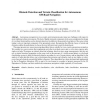Free Online Productivity Tools
i2Speak
i2Symbol
i2OCR
iTex2Img
iWeb2Print
iWeb2Shot
i2Type
iPdf2Split
iPdf2Merge
i2Bopomofo
i2Arabic
i2Style
i2Image
i2PDF
iLatex2Rtf
Sci2ools
AROBOTS
2005
2005
Obstacle Detection and Terrain Classification for Autonomous Off-Road Navigation
Autonomous navigation in cross-country environments presents many new challenges with respect to more traditional, urban environments. The lack of highly structured components in the scene complicates the design of even basic functionalities such as obstacle detection. In addition to the geometric description of the scene, terrain typing is also an important component of the perceptual system. Recognizing the different classes of terrain and obstacles enables the path planner to choose the most efficient route toward the desired goal. This paper presents new sensor processing algorithms that are suitable for cross-country autonomous navigation. We consider two sensor systems that complement each other in an ideal sensor suite: a color stereo camera, and a single axis ladar. We propose an obstacle detection technique, based on stereo range measurements, that does not rely on typical structural assumption on the scene (such as the presence of a visible ground plane); a color-based classi...
| Added | 15 Dec 2010 |
| Updated | 15 Dec 2010 |
| Type | Journal |
| Year | 2005 |
| Where | AROBOTS |
| Authors | Roberto Manduchi, Andres Castano, A. Talukder, Larry Matthies |
Comments (0)

